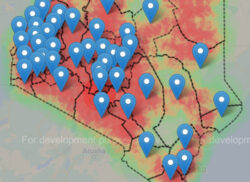
The Ministry of Health has an online application that lists all health facilities in geo-coded locations, namely the Kenya Master Health Facility List (KMHFL).
According to WHO, a master facility list (MFL) is a single, centrally maintained database of health facilities with a unique code for each facility and includes information on hours of operation, contact person, owner, facility classification, number of beds, types of services provided (e.g. Emergency Medical Obstetric Care and HIV testing), and geographic location.
In Kenya, the Master Health Facility List is an application with all health facilities and community units. Each health facility and community unit is identified with a unique code and its details describing the geographical location, administrative location, ownership, type and the services offered.
Publicly available online, KMHFL uses Global Positioning System (GPS), which directs a user to the exact location of a health centre or community units. Besides directing you to the nearest health facility, it saves you time trying to locate services needed. This is because a Master Facility lists all health facilities in a country (both public and private) and is comprised of a set of administrative information and unique identifiers and services offered.
It is especially useful for administrative purposes, the reason an MFL must contain contact information and the type of facility. In its service domain, the MFL contains a basic inventory of available services and facility capacity, providing essential information for health systems planning and management. “Consolidating health systems information through the MFL will improve record-keeping and reporting efficiency as well as transparency in the health sector,” says WHO.
In the website, you are able to view and geolocate health facilities, stand-alone health facilities and a community health unit.
A health delivery structure provides service and has one or more departments operating within it, like the outpatient, pharmacy and laboratory. In KMHFL, a facility is described by its unique code, ownership type, administrative and geographic location, and services provided. A stand-alone health facility is one that offers services that complement other facilities – consultative and curative services – while a community health unit is a structure within a defined geographic area covering a population of approximately 5,000 people. Each unit is assigned five community health extension workers (CHEWs) and community health volunteers (CHVs).
